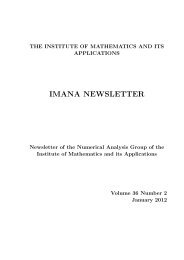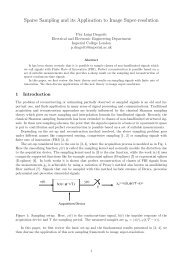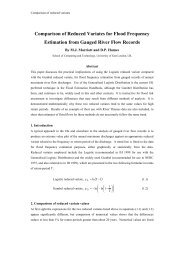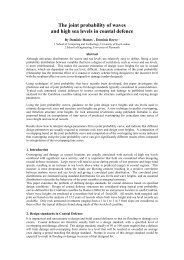Maths Arcade: stretching and supporting mathematical ... - Mathcentre
Maths Arcade: stretching and supporting mathematical ... - Mathcentre
Maths Arcade: stretching and supporting mathematical ... - Mathcentre
Create successful ePaper yourself
Turn your PDF publications into a flip-book with our unique Google optimized e-Paper software.
<strong>Maths</strong> <strong>Arcade</strong>: <strong>stretching</strong> <strong>and</strong> <strong>supporting</strong> <strong>mathematical</strong> thinking<br />
MiQube<br />
Neuron<br />
Novem<br />
Pentago<br />
Pylos<br />
Q-bitz<br />
Quads<br />
magnetic<br />
Quarto<br />
Quirky<br />
Quixo<br />
Quorridor<br />
Rubik’s cube/<br />
Hollow cube/<br />
Sudoku cube<br />
Rubik’s 360<br />
Rubik’s magic<br />
Rumis<br />
Rush Hour<br />
Saikoro<br />
1-4 players. It can be played by one player reassembling the cube or as a<br />
board game encouraging strategic thinking. It encourages special thinking.<br />
A good review on boardgamegeek:<br />
http://boardgamegeek.com/thread/261372/review-miqube<br />
1-4 players. Similar to Tantrix but less complex rules. Aim is to make the<br />
longest line of your colour.<br />
2 player tactical game. Lots of game theory involved in this. One person<br />
controls rows <strong>and</strong> the other columns <strong>and</strong> you try <strong>and</strong> capture tiles with the<br />
highest value. Strategy involves trying to work out what your opponent is<br />
going to do.<br />
2 player strategy game. Placing coloured marbles on a 6x6 board, the<br />
quadrants of which can be rotated, to form five in a row. Rules are easy to<br />
follow but the strategies take longer to assimilate. Excellent short game.<br />
2 player strategy game. Placing marbles to form a pyramid according to<br />
simple rules. Whoever places the top marble wins. Best with players of<br />
equal ability.<br />
2-4 player game. Three rounds based on speed, chance <strong>and</strong> memory.<br />
Arrange mini-cubes to make patterns. Good for encouraging symmetric<br />
visualisation.<br />
2 player game. The tiles have different combinations of colours or lines.<br />
Players take turns placing a tile so that the colours or lines on each edge<br />
match that of adjacent tiles. The player who stops his or her opponent from<br />
being able to place a tile wins. Not played very much as yet.<br />
2-4 player strategy games. Object is to get a row of 4 pieces with the same<br />
attribute. The catch is that your opponent chooses your piece for you.<br />
2-3 player strategy game. Uses coloured tokens to build equilateral triangles.<br />
Not got the hang of this game yet! Instructions are not well-explained.<br />
2-4 player strategy game. Adding <strong>and</strong> shifting tokens to form five in a row.<br />
Excellent strategy game that requires 100% concentration.<br />
2-4 player strategy game. Each player aims to move a pawn to the other<br />
side of the board but can place walls to obstruct their opponent. Good<br />
for programmers.<br />
The classic puzzle <strong>and</strong> variants. There are many books <strong>and</strong> websites<br />
explaining how to explain Group Theory using a Rubik’s Cube.<br />
Puzzle. Involves changing the position of six coloured balls in a central<br />
sphere to six coloured compartments in an outer sphere, by manoeuvring<br />
them through a middle sphere that only has two holes.<br />
Puzzle. Folding connected tiles to form a pattern.<br />
2-4 player strategy game. Involves placing blocks onto a board as part of a<br />
3D structure to capture available space. Not played much.<br />
1 or more player strategy game. The objective is to move a red car out of a<br />
six-by-six grid by moving the other vehicles out of its way. There are many<br />
variations on this including online versions <strong>and</strong> apps for iPads etc. Similar to<br />
Red Donkey.<br />
2 player game with lots of dice. Easy to earn <strong>and</strong> demonstrated on ‘Board<br />
Games with Scott’. Involves finding a way of removing dice to trap your<br />
opponent. http://www.boardgameswithscott.com/?p=84<br />
36



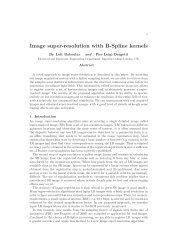

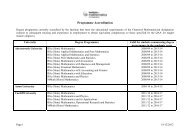
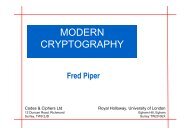
![Download NLAO Application Form [PDF] - Institute of Mathematics ...](https://img.yumpu.com/22617151/1/184x260/download-nlao-application-form-pdf-institute-of-mathematics-.jpg?quality=85)
![Download Education Grants Application Form [PDF] - Institute of ...](https://img.yumpu.com/22617149/1/184x260/download-education-grants-application-form-pdf-institute-of-.jpg?quality=85)
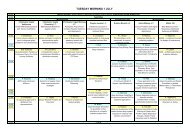
![IMA IPD brochure [PDF] - Institute of Mathematics and its Applications](https://img.yumpu.com/22617139/1/189x260/ima-ipd-brochure-pdf-institute-of-mathematics-and-its-applications.jpg?quality=85)

